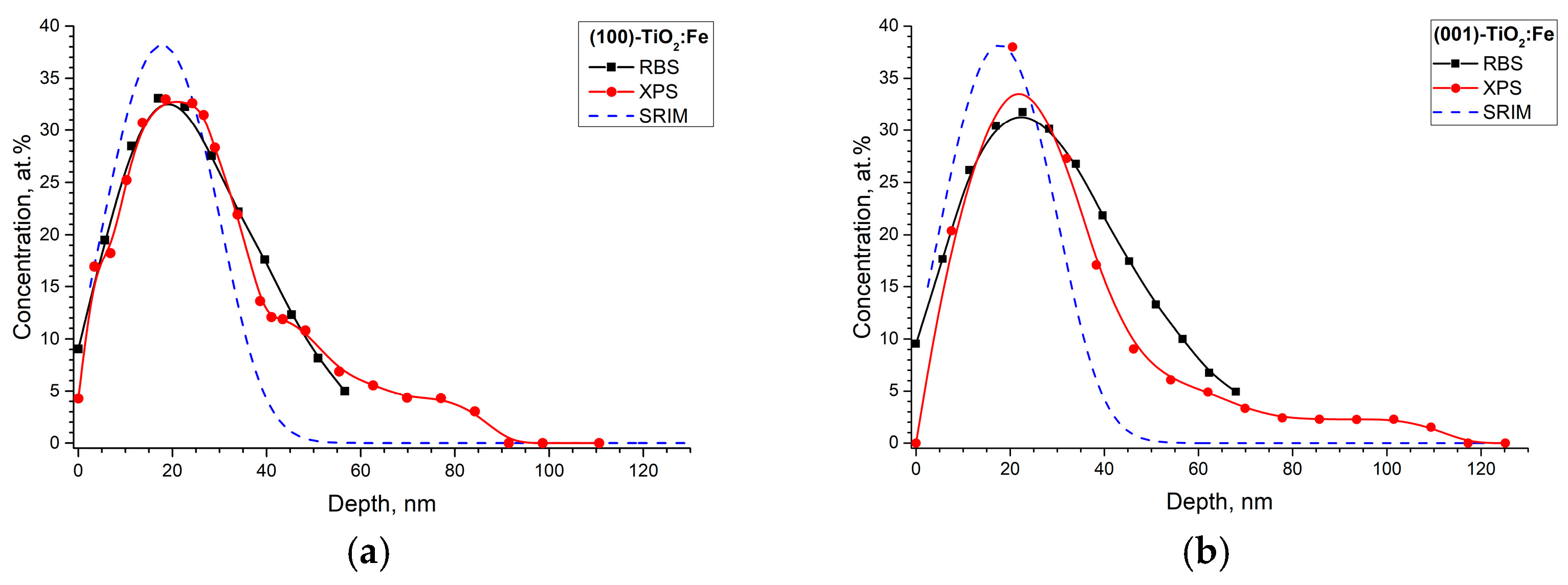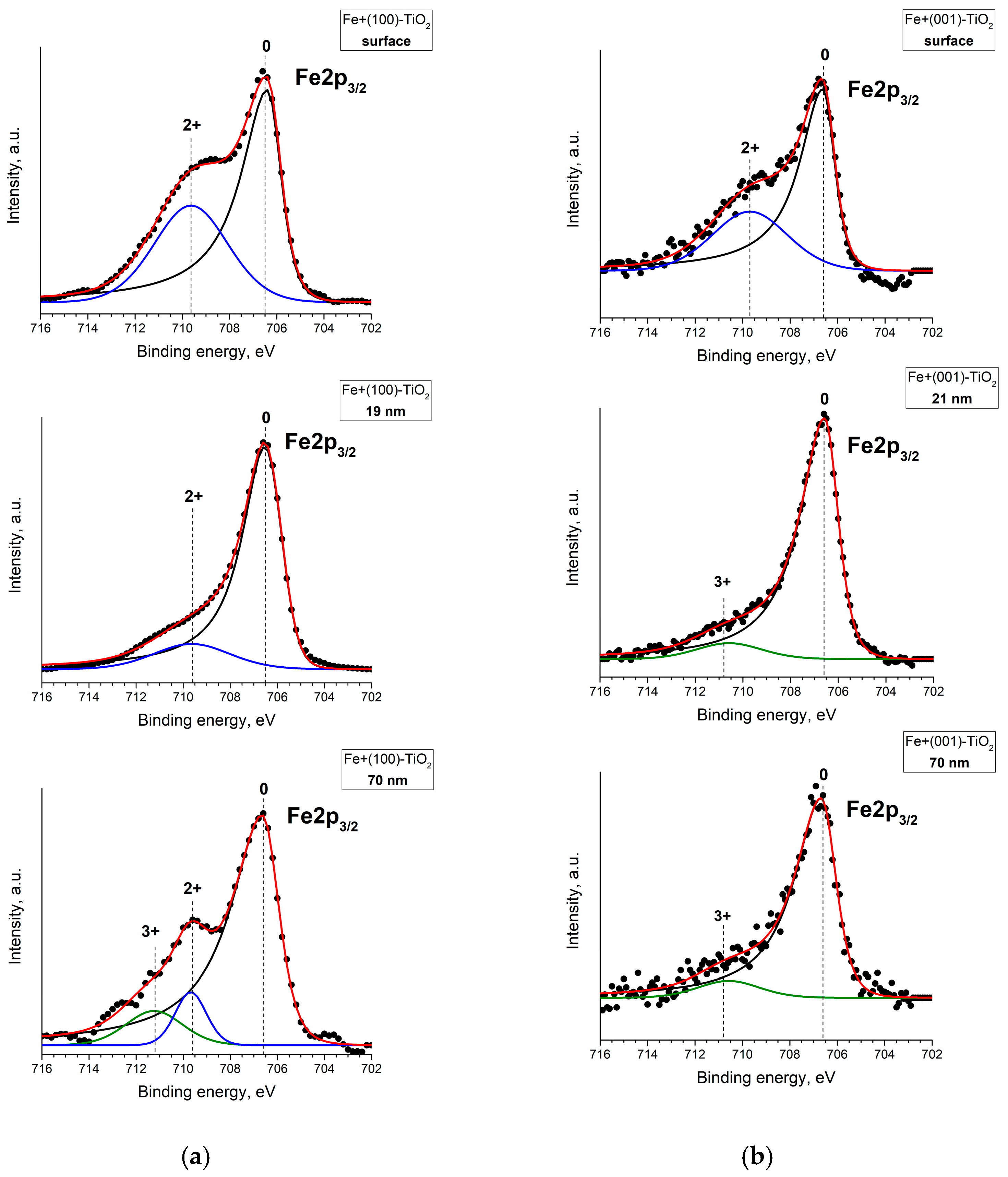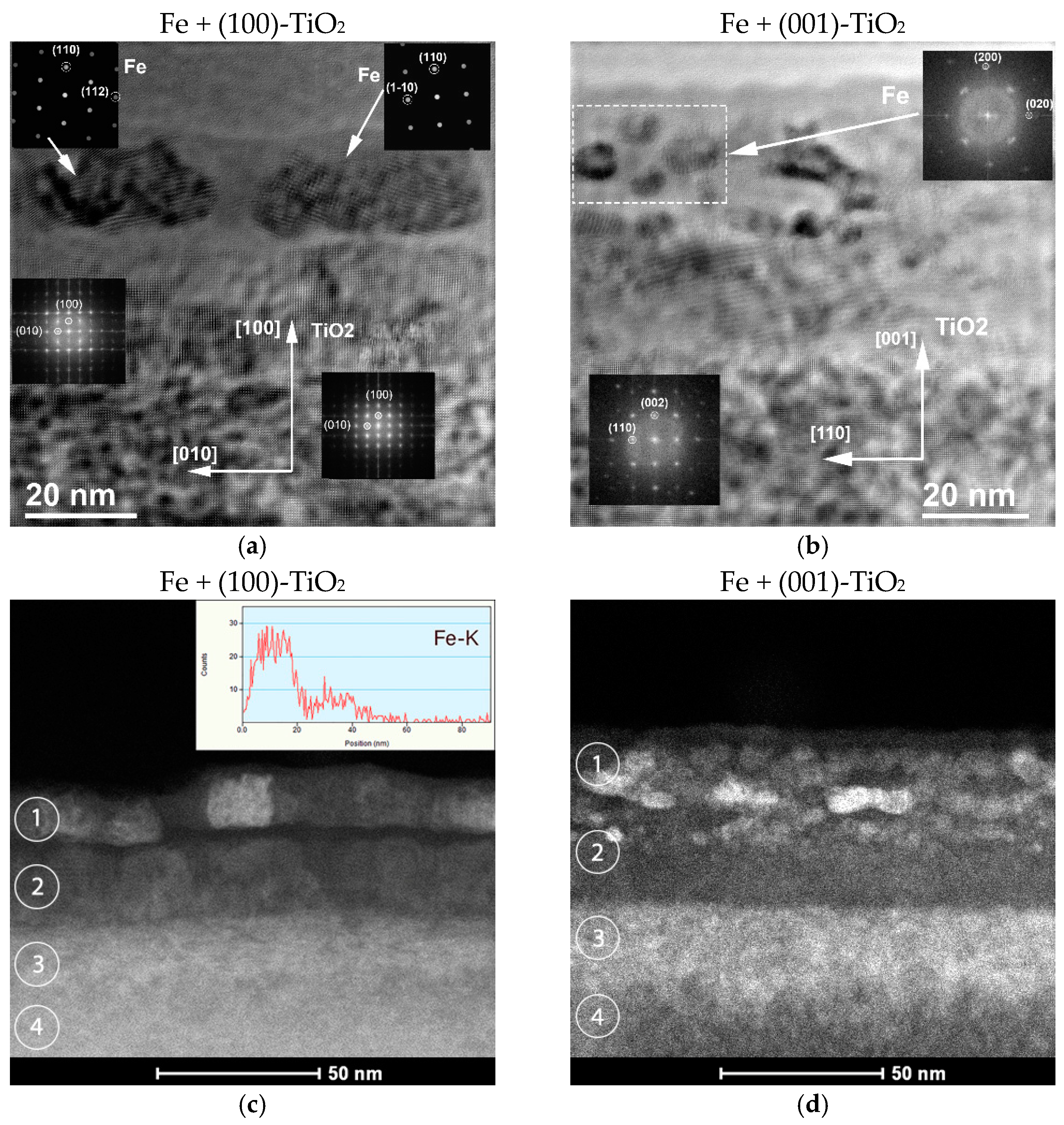Ion-Beam Synthesis of Structure-Oriented Iron Nanoparticles in Single-Crystalline Rutile TiO2
Abstract
:1. Introduction
2. Experimental Part
3. Results and Discussion
4. Conclusions
Supplementary Materials
Author Contributions
Funding
Institutional Review Board Statement
Informed Consent Statement
Data Availability Statement
Acknowledgments
Conflicts of Interest
References
- Dietl, T. Spintronics and ferromagnetism in wide-band-gap semiconductors. AIP Conf. Proc. 2005, 772, 56–64. [Google Scholar] [CrossRef] [Green Version]
- Chambers, S.A. Ferromagnetism in doped thin-film oxide and nitride semiconductors and dielectrics. Surf. Sci. Rep. 2006, 61, 345–381. [Google Scholar] [CrossRef]
- Hirohata, A.; Yamada, K.; Nakatani, Y.; Prejbeanu, I.-L.; Diény, B.; Pirro, P.; Hillebrands, B. Review on spintronics: Principles and device applications. J. Magn. Magn. Mater. 2020, 509, 166711. [Google Scholar] [CrossRef]
- Gupta, A.; Zhang, R.; Kumar, P.; Kumar, V.; Kumar, A. Nano-Structured Dilute Magnetic Semiconductors for Efficient Spintronics at Room Temperature. Magnetochemistry 2020, 6, 15. [Google Scholar] [CrossRef] [Green Version]
- Coey, J.M.D.; Chambers, S.A. Oxide Dilute Magnetic Semiconductors—Fact or Fiction? MRS. Bull. 2011, 33, 1053–1058. [Google Scholar] [CrossRef]
- Ryssel, H.; Ruge, I. Ion Implantation; Wiley: Chichester, UK, 1986. [Google Scholar]
- Potzger, K. Ion-beam synthesis of magnetic semiconductors. Nucl. Instruments Methods Phys. Res. Sect. B Beam Interact. Mater. Atoms 2012, 272, 78–87. [Google Scholar] [CrossRef]
- Afify, N.; Abbady, G.; Hamad, D.; Abdelbaki, R.F.; Yousef, E.S.; Shaaban, E.R.; Abd-el Salam, M.N. The effective role of dilute Co on SnO2 nanoparticles: Structural, optical and magnetic characterization properties for spintronics. Sens. Actuator Phys. 2021, 331, 112984. [Google Scholar] [CrossRef]
- Morozov, I.G.; Belousova, O.V.; Blanco-Andujar, C.; Ortega, D.; Kuznetsov, M.V. Structural, optical, magnetic, and XPS properties of SnOx nanoparticles. Solid State Sci. 2022, 126, 106854. [Google Scholar] [CrossRef]
- Ahsan, H.F.; Lal, K.; Saleem, M.; Mustafa, G.M.; Khan, M.A.; Haidyrah, A.S.; Atiq, S. Tuning the dielectric behavior and energy storage properties of Mn/Co co-doped ZnO. Mater. Sci. Semicond. Process. 2021, 134, 105977. [Google Scholar] [CrossRef]
- Naseem, S.; Pinchuk, I.V.; Luo, Y.K.; Kawakami, R.K.; Khan, S.; Husain, S.; Khan, W. Epitaxial growth of cobalt doped TiO2 thin films on LaAlO3 substrate by molecular beam epitaxy and their opto-magnetic based applications. Appl. Surf. Sci. 2019, 493, 691–702. [Google Scholar] [CrossRef]
- Waseem, S.; Anjuma, S.; Zeeshan, T.; Mustafa, L.; Kayani, Z.N.; Majid, F.; Warsi, A.; Shah, S.I. Pulsed laser deposited Cobalt doped Ti0.9Fe0.1-xO2 thin films: Structural, morphological, magnetic, optical and electrical properties. Ceram. Int. 2021, 47, 8555–8565. [Google Scholar] [CrossRef]
- Chen, H.; Zhang, Y.; Wu, Z.; Qin, Z.; Wu, S.; Hu, W. Substrate temperature dependence of chemical state and magnetoresistance characteristics of Co–TiO2 nanocomposite films. Trans. Nonferrous Met. Soc. China 2020, 30, 2502–2509. [Google Scholar] [CrossRef]
- Ho, J.; de Boer, T.; Braun, P.M.; Leedahl, B.; Manikandan, D.; Murugan, R.; Moewes, A. Origin and control of room temperature ferromagnetism in Co,Zn-doped SnO2: Oxygen vacancies and their local environment. J. Mater. Chem. C 2020, 8, 4902–4908. [Google Scholar] [CrossRef]
- Garnet, N.S.; Ghodsi, V.; Hutfluss, L.N.; Yin, P.; Hegde, M.; Radovanovic, P.V. Probing the Role of Dopant Oxidation State in the Magnetism of Diluted Magnetic Oxides Using Fe-Doped In2O3 and SnO2 Nanocrystals. J. Phys. Chem. C 2017, 121, 1918–1927. [Google Scholar] [CrossRef]
- Jiang, F.; Chen, D.; Zhou, G.; Wang, Y.; Xu, X. The dramatic enhancement of ferromagnetism and band gap in Fe-doped In2O3 nanodot arrays. Sci. Rep. 2018, 8, 2417. [Google Scholar] [CrossRef] [PubMed] [Green Version]
- Dhamodaran, M.; Karuppannan, R.; Murugan, R.; Boukhvalov, D.W.; Pandian, M.S.; Perumalsamy, R. Morphology controlled synthesis of Fe and Mn co-doped In2O3 nanocubes and their Dopant-Atom effects on electronic structure and magnetic properties. J. Magn. Magn. Mater. 2022, 560, 169547. [Google Scholar] [CrossRef]
- Matsumoto, Y.; Murakami, M.; Shono, T.; Hasegawa, T.; Fukuruma, T.; Kawasaki, M.; Ahmet, P.; Chikyow, T.; Koshihara, S.; Koinuma, H. Room-Temperature Ferromagnetism in Transparent Transition Metal-Doped Titanium Dioxide. Science 2001, 291, 854–856. [Google Scholar] [CrossRef]
- Dietl, T. A ten-year perspective on dilute magnetic semiconductors and oxides. Nat. Mater. 2010, 9, 965–974. [Google Scholar] [CrossRef] [Green Version]
- Yakout, S.M. Room Temperature Ferromagnetism: Nonmagnetic Semiconductor Oxides and Nonmagnetic Dopants. J. Electron. Mater. 2021, 50, 1922–1941. [Google Scholar] [CrossRef]
- Vokoun, D.; Svatuška, M.; Olejníček, J.; Kohout, M.; Drahokoupil, J.; Rameš, M.; Vejpravová, J.; Mantlíková, A.; Fekete, L.; Kopeček, J.; et al. Ni–TiO2 nanocomposite films and their magnetic properties. Phys. B Condens. Matter. 2016, 503, 44–50. [Google Scholar] [CrossRef]
- Darapaneni, P.; Moura, N.S.; Harry, D.; Cullen, D.A.; Dooley, K.M.; Dorman, J.A. Effect of Moisture on Dopant Segregation in Solid Hosts. J. Phys. Chem. C 2019, 123, 12234–12241. [Google Scholar] [CrossRef]
- Vokoun, D.; Vronka, M.; Rameš, M.; Olejníček, J.; Kohout, M.; Heczko, O. Ni nanoparticles in TiO2 films and their magnetic properties. Physica B Condens. Matter. 2020, 578, 411862. [Google Scholar] [CrossRef]
- Saadaoui, H.; Luo, X.; Salman, Z.; Cui, X.Y.; Bao, N.N.; Bao, P.; Zheng, R.K.; Tseng, L.T.; Du, Y.H.; Prokscha, T.; et al. Intrinsic Ferromagnetism in the Diluted Magnetic Semiconductor Co:TiO2. Phys. Rev. Lett. 2016, 117, 227202. [Google Scholar] [CrossRef] [Green Version]
- Zhang, H.; Huang, W.; Lin, R.; Wang, Y.; Long, B.; Hu, Q.; Wu, Y. Room temperature ferromagnetism in pristine TiO2 nanoparticles triggered by singly ionized surface oxygen vacancy induced via calcining in different air pressure. J. Alloy Compd. 2021, 860, 157913. [Google Scholar] [CrossRef]
- Joshi, S.R.; Padmanabhan, B.; Chanda, A.; Shukla, N.; Malik, V.K.; Kanjilal, D.; Verma, S. Anisotropic super-paramagnetism in cobalt implanted rutile-TiO2 single crystals. J. Magn. Magn. Mater. 2018, 465, 122–127. [Google Scholar] [CrossRef] [Green Version]
- Shutthanandan, V.; Thevuthasan, S.; Heald, S.M.; Droubay, T.; Engelhard, M.H.; Kaspar, T.C.; McCready, D.E.; Saraf, L.; Chambers, S.A. Room-temperature ferromagnetism in ion-implanted Co-doped TiO2 rutile. Appl. Phys. Lett. 2004, 84, 4466–4468. [Google Scholar] [CrossRef]
- Luk, W.Y.; Wong, S.P.; Ke, N.; Li, Q.; Lindner, J.K.N. Structural and magnetic properties of cobalt implanted TiO2 thin films. Proc. SPIE 2006, 6415, 162–170. [Google Scholar] [CrossRef]
- Zhu, S.; Wang, L.M.; Zu, X.T.; Xiang, X. Optical and magnetic properties of Ni nanoparticles in rutile formed by Ni ion implantation. Appl. Phys. Lett. 2006, 88, 43107. [Google Scholar] [CrossRef] [Green Version]
- Zhou, S.; Talut, G.; Potzger, K.; Shalimov, A.; Grenzer, J.; Skorupa, W.; Helm, M.; Fassbender, J.; Čižmár, E.; Zvyagin, S.A.; et al. Crystallographically oriented Fe nanocrystals formed in Fe-implanted TiO2. J. Appl. Phys. 2008, 103, 83907. [Google Scholar] [CrossRef]
- Cheng, F.; Ding, B.; Pan, F.; Yao, S.; Potzger, K.; Zhou, S. Investigation on the structural and magnetic properties of Co+ implanted rutile TiO2. Nucl. Instruments Methods Phys. Res. Sect. B Beam Interact. Mater. Atoms. 2012, 286, 180–183. [Google Scholar] [CrossRef]
- Ding, B.; Cheng, F.; Pan, F.; Fa, T.; Yao, S.; Potzger, K.; Zhou, S. The correlation between structure and magnetism of Ni-implanted TiO2 annealed at different temperatures. J. Magn. Magn. Mater. 2012, 324, 33–36. [Google Scholar] [CrossRef]
- Cruz, M.M.; da Silva, R.C.; Pinto, J.V.; Borges, R.P.; Franco, N.; Casaca, A.; Alves, E.; Godinho, M. Formation of oriented nickel aggregates in rutile single crystals by Ni implantation. J. Magn. Magn. Mater. 2013, 340, 102–108. [Google Scholar] [CrossRef] [Green Version]
- Silva, C.; Costa, A.R.G.; da Silva, R.C.; Alves, L.C.; Ferreira, L.P.; Carvalho, M.D.; Franco, N.; Godinho, M.; Cruz, M.M. Magnetic and electrical characterization of TiO2 single crystals co-implanted with iron and cobalt. J. Magn. Magn. Mater. 2014, 364, 106–116. [Google Scholar] [CrossRef]
- Cortie, D.L.; Khaydukov, Y.; Keller, T.; Sprouster, D.J.; Hughes, J.S.; Sullivan, J.P.; Wang, X.L.; Le Brun, A.P.; Bertinshaw, J.; Callori, S.J.; et al. Enhanced Magnetization of Cobalt Defect Clusters Embedded in TiO2−δ Films. ACS Appl. Mater. Interfaces 2017, 9, 8783–8795. [Google Scholar] [CrossRef] [PubMed]
- Khaibullin, R.I.; Tagirov, L.R.; Rameev, B.Z.; Ibragimov, S.Z.; Yildiz, F.; Aktaş, B. High Curie-temperature ferromagnetism in cobalt-implanted single-crystalline rutile. J. Phys. Condens. Matter. 2004, 16, L443. [Google Scholar] [CrossRef]
- Khaibullin, R.I.; Ibragimov, S.Z.; Tagirov, L.R.; Popok, V.N.; Khaibullin, I.B. Formation of anisotropic ferromagnetic response in rutile (TiO2) implanted with cobalt ions. Nucl. Instruments Methods Phys. Res. Sect. B Beam Interact. Mater. Atoms. 2007, 257, 369–373. [Google Scholar] [CrossRef]
- Akdogan, N.; Nefedov, A.; Zabel, H.; Westerholt, K.; Becker, H.-W.; Somsen, C.; Gök, Ş.; Bashir, A.; Khaibullin, R.; Tagirov, L. High-temperature ferromagnetism in Co-implanted TiO2 rutile. J. Phys. D Appl. Phys. 2009, 42, 115005. [Google Scholar] [CrossRef] [Green Version]
- Achkeev, A.A.; Khaibullin, R.I.; Tagirov, L.R.; Mackova, A.; Hnatowicz, V.; Cherkashin, N. Specific features of depth distribution profiles of implanted cobalt ions in rutile TiO2. Phys. Solid State 2011, 53, 543–553. [Google Scholar] [CrossRef]
- Okay, C.; Vakhitov, I.R.; Valeev, V.F.; Khaibullin, R.I.; Rameev, B. Magnetic Resonance Study of Fe-Implanted TiO2 Rutile. Appl. Magn. Reson. 2017, 48, 347–360. [Google Scholar] [CrossRef]
- Vakhitov, I.R.; Lyadov, N.M.; Valeev, V.F.; Nuzhdin, V.I.; Tagirov, L.R.; Khaibullin, R.I. Effects of nickel ions implantation and subsequent thermal annealing on structural and magnetic properties of titanium dioxide. J. Phys. Conf. Ser. 2014, 572, 012048. [Google Scholar] [CrossRef] [Green Version]
- Vakhitov, I.R.; Shemukhin, A.A.; Gumarov, A.I.; Lyadov, N.M.; Nuzhdin, V.I.; Faizrakhmanov, I.A.; Okay, C.; Rameev, B.Z.; Tagirov, L.R.; Khaibullin, R.I. Structural and magnetic studies of TiO2 rutile implanted with vanadium ions. Mater. Res. Express 2019, 6, 116103. [Google Scholar] [CrossRef]
- Fairley, N.; Fernandez, V.; Richard-Plouet, M.; Guillot-Deudon, C.; Walton, J.; Smith, E.; Flahaut, D.; Greiner, M.; Biesinger, M.; Tougaard, S.; et al. Systematic and collaborative approach to problem solving using X-ray photoelectron spectroscopy. Appl. Surf. Sci. Adv. 2021, 5, 100112. [Google Scholar] [CrossRef]
- Was, G.S.; Taller, S.; Jiao, Z.; Monterrosa, A.M.; Woodley, D.; Jennings, D.; Kubley, T.; Naab, F.; Toader, O.; Uberseder, E. Resolution of the carbon contamination problem in ion irradiation experiments. Nucl. Instruments Methods Phys. Res. Sect. B Beam Interact. Mater. Atoms. 2017, 412, 58–65. [Google Scholar] [CrossRef]
- Drouin, D.; Couture, A.R.; Joly, D.; Tastet, X.; Aimez, V.; Gauvin, R. CASINO V2.42—A Fast and Easy-to-use Modeling Tool for Scanning Electron Microscopy and Microanalysis Users. Scanning 2007, 29, 92–101. [Google Scholar] [CrossRef] [PubMed]
- Ziegler, J.F.; Ziegler, M.D.; Biersack, J.P. SRIM—The stopping and range of ions in matter (2010). Nucl. Instrum. Methods Phys. Res. Sect. B Beam Interact. Mater. Atoms. 2010, 268, 1818–1823. [Google Scholar] [CrossRef] [Green Version]
- NIST X-ray Photoelectron Spectroscopy Database, NIST Standard Reference Database Number 20; National Institute of Standards and Technology: Gaithersburg, MD, USA, 2000. [CrossRef]
- Bean, C.P.; Livingston, J.D. Superparamagnetism. J. Appl. Phys. 1959, 30, S120–S129. [Google Scholar] [CrossRef]
- Majetich, S.A.; Sachan, M. Magnetostatic interactions in magnetic nanoparticle assemblies: Energy, time and length scales. J. Phys. D Appl. Phys. 2006, 39, R407–R422. [Google Scholar] [CrossRef]
- Kittel, C. Introduction to Solid State Physics; Wiley: New York, NY, USA, 1976. [Google Scholar]






| No. | Plate Orientation | Fluence, Ion/cm2 | Elemental Composition, at. % | Fe/Ti | |||
|---|---|---|---|---|---|---|---|
| C | O | Ti | Fe | ||||
| 1 | (100) | - | 1.88 | 70.36 | 27.75 | - | - |
| 2 | (100) | 0.5 × 1017 | 2.85 | 65.84 | 27.20 | 4.11 | 0.15 |
| 3 | (001) | 2.13 | 65.1 | 28.18 | 4.6 | 0.16 | |
| 4 | (100) | 1.0 × 1017 | 4.68 | 61.68 | 26.03 | 7.61 | 0.29 |
| 5 | (001) | 3.07 | 61.04 | 27.39 | 8.5 | 0.31 | |
| 6 | (100) | 1.5 × 1017 | 4.12 | 58.77 | 26.7 | 10.4 | 0.39 |
| 7 | (001) | 2.63 | 58.81 | 26.9 | 11.66 | 0.43 | |
Disclaimer/Publisher’s Note: The statements, opinions and data contained in all publications are solely those of the individual author(s) and contributor(s) and not of MDPI and/or the editor(s). MDPI and/or the editor(s) disclaim responsibility for any injury to people or property resulting from any ideas, methods, instructions or products referred to in the content. |
© 2023 by the authors. Licensee MDPI, Basel, Switzerland. This article is an open access article distributed under the terms and conditions of the Creative Commons Attribution (CC BY) license (https://creativecommons.org/licenses/by/4.0/).
Share and Cite
Vakhitov, I.R.; Lyadov, N.M.; Vdovin, V.I.; Gutakovskii, A.K.; Nuzhdin, V.I.; Tagirov, L.R.; Khaibullin, R.I. Ion-Beam Synthesis of Structure-Oriented Iron Nanoparticles in Single-Crystalline Rutile TiO2. Crystals 2023, 13, 355. https://doi.org/10.3390/cryst13020355
Vakhitov IR, Lyadov NM, Vdovin VI, Gutakovskii AK, Nuzhdin VI, Tagirov LR, Khaibullin RI. Ion-Beam Synthesis of Structure-Oriented Iron Nanoparticles in Single-Crystalline Rutile TiO2. Crystals. 2023; 13(2):355. https://doi.org/10.3390/cryst13020355
Chicago/Turabian StyleVakhitov, Iskander R., Nikolay M. Lyadov, Vladimir I. Vdovin, Anton K. Gutakovskii, Vladimir I. Nuzhdin, Lenar R. Tagirov, and Rustam I. Khaibullin. 2023. "Ion-Beam Synthesis of Structure-Oriented Iron Nanoparticles in Single-Crystalline Rutile TiO2" Crystals 13, no. 2: 355. https://doi.org/10.3390/cryst13020355
APA StyleVakhitov, I. R., Lyadov, N. M., Vdovin, V. I., Gutakovskii, A. K., Nuzhdin, V. I., Tagirov, L. R., & Khaibullin, R. I. (2023). Ion-Beam Synthesis of Structure-Oriented Iron Nanoparticles in Single-Crystalline Rutile TiO2. Crystals, 13(2), 355. https://doi.org/10.3390/cryst13020355








